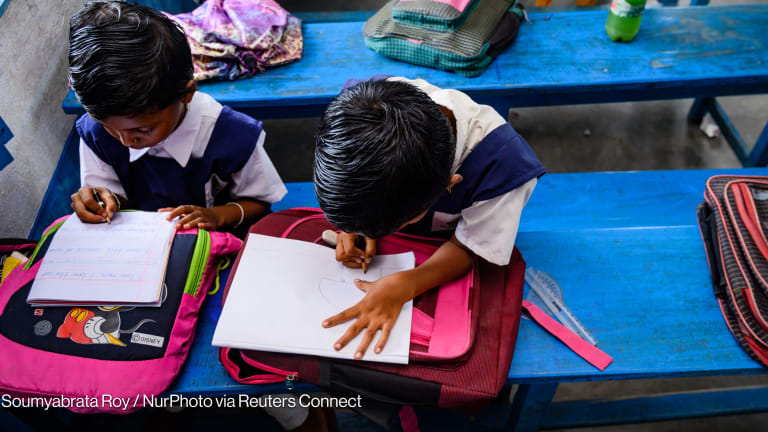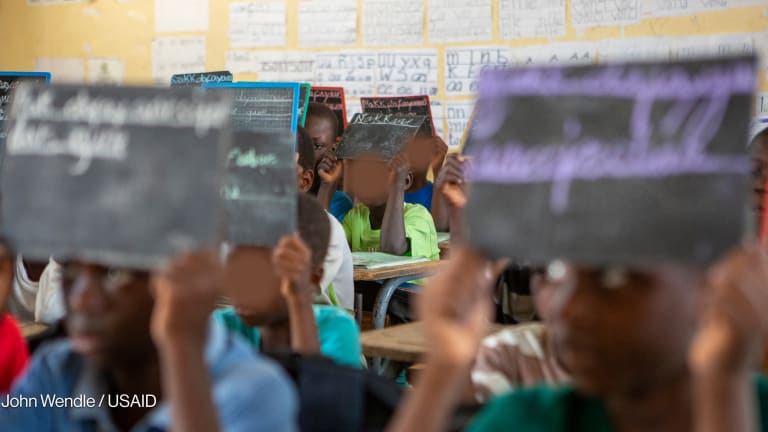
LONDON — The world’s largest education development impact bond, which has raised $11 million to pay for improved learning outcomes for 300,000 primary school kids in India, achieved mixed results in its first year, an evaluation has found.
Figures from year one of the Quality Education India DIB were released last week, although the full evaluation has not been published. The numbers released show that 40% of participating schools either met or exceeded their targets for literacy and numeracy skills.
“For this to be sustainable, it will be critical to move beyond donor funding and for governments to engage.”
— Emily Gustafsson-Wright, fellow, Brookings Institution’s Center for Universal EducationHowever, 60% of schools failed to outperform nonparticipating schools, and a teacher training program in north Delhi that underperformed has since been discontinued.
The bond kicked off in September 2018 and is the most ambitious application of the innovative financing mechanism in education to date. It will run for four years and aims to improve numeracy and literacy outcomes for children aged 5-11 across 600 schools in Delhi and Gujarat.
The Educate Girls DIB exceeded its goals
The DIB’s final results showed it significantly exceeded its learning targets, returned money to its investor, and shed some light on this innovative financing tool.
It was launched on the back of the success of the Educate Girls DIB, the first to be tried in education, which closed in 2018 having surpassed its targets to improve learning and get girls enrolled in schools across Rajasthan. The model reached approximately 7,000 children.
Amid declining aid budgets, impact bonds have been growing in popularity in recent years. The alternative financing mechanism for development aims to bring in new investors and improve performance by shifting the focus to paying for outcomes, instead of inputs, and allowing service providers to be more data-driven and manage adaptively.
According to the Brookings Institution, as of January, seven DIBs were either completed or in implementation around the world.
However, not everyone is convinced by the model — DIBs are expensive to structure and evaluate. They also doubt whether they can work in education because of the incentive structures they create.
The Quality Education India DIB is much bigger than its predecessor, working with a range of implementing NGOs carrying out different interventions — whereas Educate Girls employed just one — and targeting more students and schools. The aim is to find out whether the model can work at scale.
Richard Hawkes, head of the British Asian Trust, which is leading the DIB, said that adjustments were to be expected in the “start-up year” for both the DIB and NGOs involved, but that things were on track. The Educate Girls DIB did not start meeting its targets until the final year of implementation.
“The ambition remains that the learnings from the DIB will be used to create an education ‘rate card,’ an assessment of costs for tried-and-tested delivery outcomes against funding, to improve the quality of education,” he said in a press release.
DevExplains: Development impact bonds
DIBs are often tossed around as a potential innovative financing mechanism. This video explores what they are, how they work, and when they should be used.
In a DIB, an investor provides upfront capital for an intervention that is implemented by one or more service providers. If the program achieves pre-agreed results, then the outcome payer — usually a foundation or donor agency — pays the investor based on how well the intervention worked.
As with the Educate Girls DIB, UBS Optimus Foundation is providing the upfront capital for QEI — $3 million, which will be recycled back into the program if outcomes are met.
However, where the earlier bond had just one outcome payer, the new DIB has five: the Michael & Susan Dell Foundation, Comic Relief, the Mittal Foundation, Lawrence Ellison Foundation, and British Telecom.
The total outcome fund raised to date is $11 million, but the goal is to double this.
In year one, the funding was split between three Indian NGOs — the Kaivalya Education Foundation, Gyan Shala, and Society for All Round Development.
First year results showed that “the outcome payment for risk investors is on track, with the results averaged out over the lifetime of the DIB,” according to a press release.
The targets are focused on learning outcomes alone, which critics say can create perverse incentives for operators to exclude poor performing students, who tend to be from low-income communities, or teach to the test. The Educate Girls DIB tackled this by also having inclusion targets.
However, Abha Thorat-Shah, executive director for social finance at the British Asian Trust, said that most of the QEI partners are working in government schools or slum communities, and so the students already tend to be from the most disadvantaged backgrounds.
She also said that the learning targets and assessment have been carefully designed to ensure students are achieving real growth.
“Growth in learning means that children demonstrate higher proficiency of skills as they move through the grades … [and] they gain mastery of topics to go beyond just knowledge to apply their knowledge in real-world contexts,” she told Devex.
The year one evaluation revealed that some of the programs underperformed. The teacher training intervention run by Society for All Round Development was dropped, but it continues to run its other DIB program, helping children who have fallen behind.
Phyllis Costanza, CEO at the UBS Optimus Foundation, said the decision to discontinue funding to one of the programs showed the funder was serious about meeting its targets.
"We closely monitor the programs we're funding, we challenge assumptions regularly, and we hold grantees to extremely high standards of performance,” she said.
Other changes in year two will include the roll-out of Mindspark, a computer-based adaptive learning software, in 55 schools. The program is being implemented by the Pratham Infotech Foundation.
Education assessment company, Gray Matters India, carried out the evaluation which compared learning across more than 12,000 students randomly selected from schools taking part in the DIB with students from nonparticipating schools. A final evaluation will be made public at the end of year four.
Chirantan Shah, a special adviser at Gyan Shala, which is set to run 340 free schools for children in slums in Ahmedabad and Surat, told Devex that their experience working on the DIB had been positive so far.
The structure has given them flexibility and freedom to operate without “meddling” from donors, and the upfront funding from the DIB enabled them to limit student class sizes to 25 and teacher training classes to 9, he said.
The four-year funding window “provides organizations with sufficient time to get their act together and demonstrate they are delivering high-quality learning with high efficiency,” Shah added.
However, working with local government is an ongoing challenge, he said. This is significant since DIBs will need government buy-in in order to achieve scale, potentially becoming the outcome buyer.
“For this to be sustainable, it will be critical to move beyond donor funding and for governments to engage,” Emily Gustafsson-Wright, a fellow at the Brookings Institution’s Center for Universal Education, told Devex.








